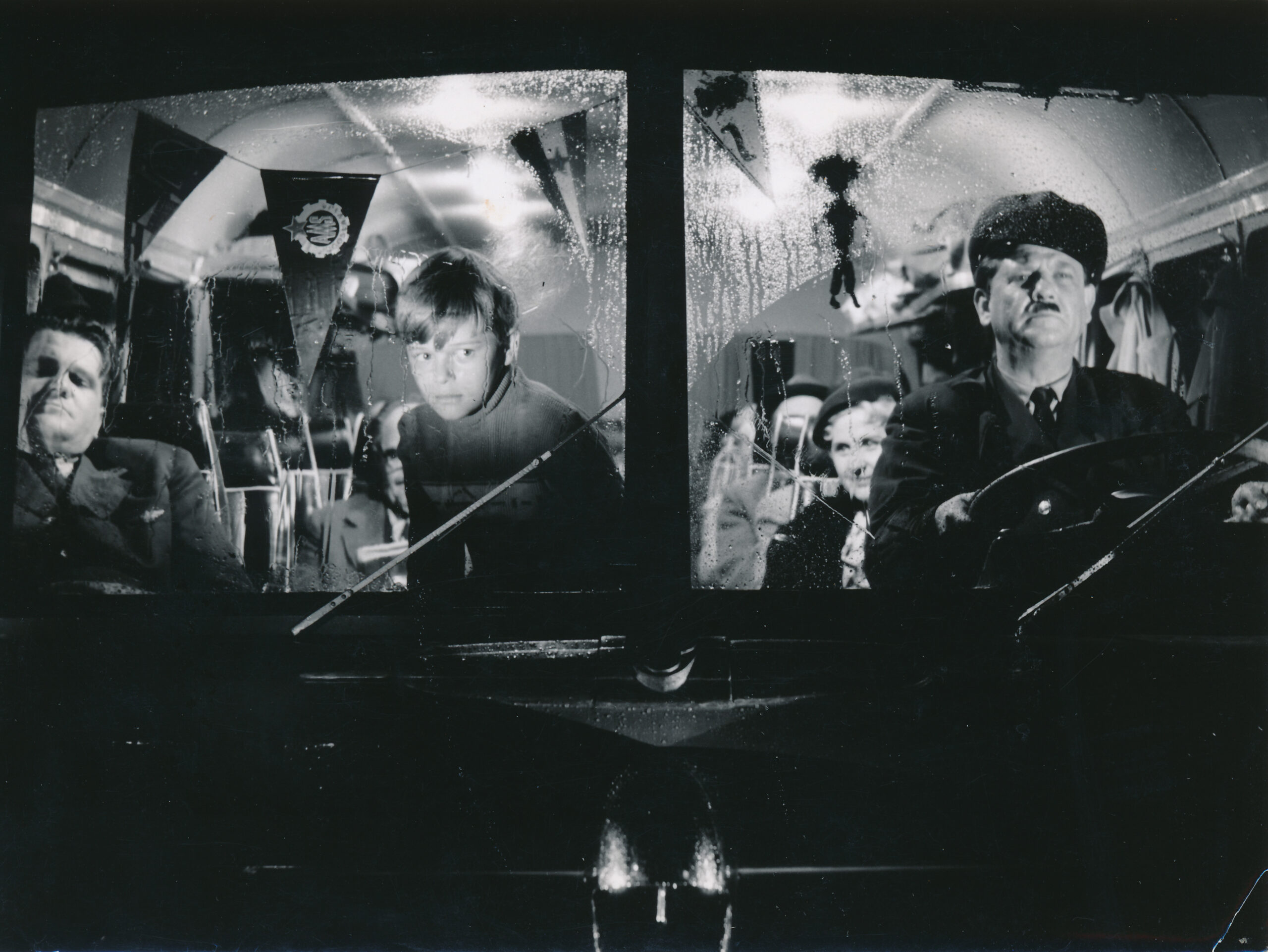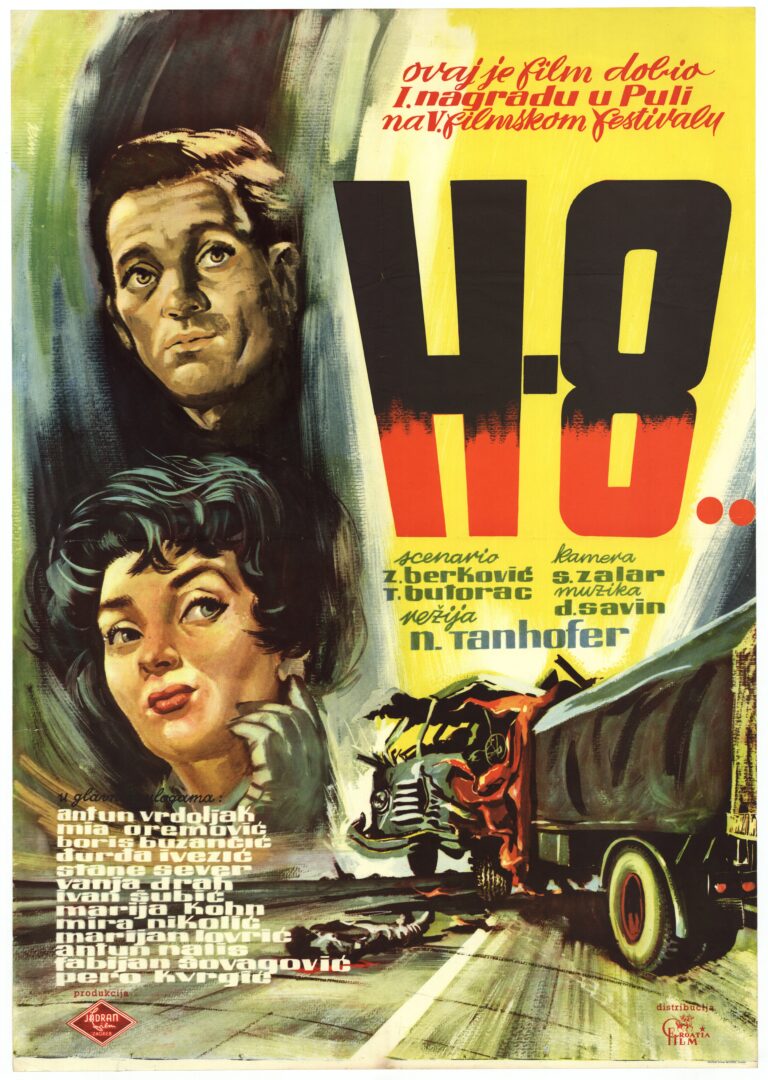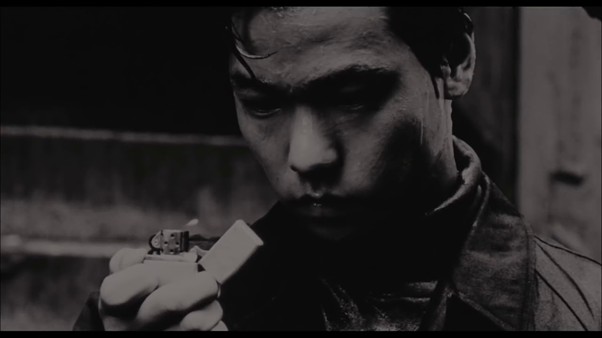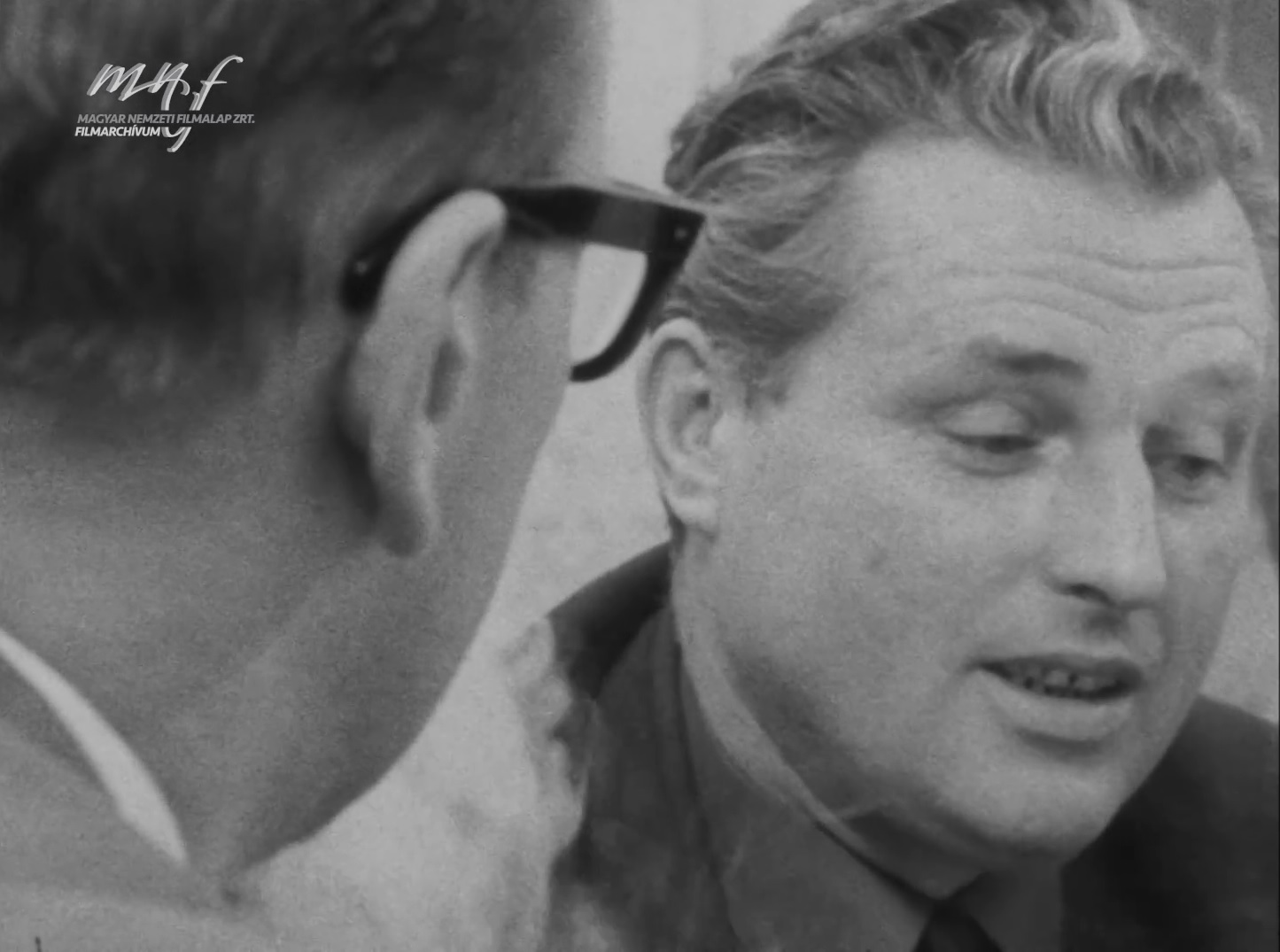
H-8…: A Spectacle Within
By Juraj Kukoč
Croatian cinema has never been a cinema of spectacle, neither when it was a part of Yugoslav cinema nor after it gained its independence. Croatian cinema has rather been a cinema of structurally coherent low-key dramas often situated in narrow spaces. Even in the genre of partisan films (World War II films) that thrived in Yugoslavia, unlike Serbian spectacular war epics, Croatian partisan movies were often situated in closed spaces or narrow city streets and dubbed “chamber partisan movies”. Unlike Serbian action war movies, they were war dramas or, at best, war thrillers.
Therefore, it is not surprising that in the latest poll conducted among Croatian film critics in 2020, a drama with elements of the thriller situated almost completely in the interior space of a bus and a truck was selected as the greatest Croatian film of all time. The film is called H-8… (Nikola Tanhofer, 1958) and it is based on a real event: a traffic accident, intensely covered by Yugoslav media of the period, in which a car provoked a crash between a bus and a truck on the highway between Zagreb and Belgrade and the culprit fled the scene of the crime. Witnesses remembered only the two first signs of the car license plate: H-8 (hence the title of the movie). The car and its owner were never found. Authors of the movie H-8… drew upon factual data of the accident as the framework for the story about fictionalized passengers of the bus and the driver of the truck in the period before the accident. The driver remained a mystery in the film as well as in real life. The film leaves the bus and the truck on two occasions and only to replace them with other closed spaces: the bus station at the beginning of the film and a bar and restaurant where both vehicles make a stop in the middle of the story.
Nikola Tanhofer, an esteemed director of photography in his early days, became a film director in the late 1950s and in H-8…, his second film as a director, he showed what brilliant things he can do with a camera in a closed space. Ironically, Tanhofer’s chamber movie is one of the rare truly spectacular Croatian films, a proof that Croatian cinema can also be a cinema of spectacle. Croatian film critic Jurica Pavičić claimed that H-8… belongs to the genre of disaster movies, proving that it follows almost all rules of the genre[1], but its spectacular quality is not in the representation of disaster itself. H-8… lacks the spectacular scenes which traditionally characterise disaster movies. Indeed, spectacularism in the prologue of the film is achieved through a sequence linked to the disaster, in which two narrators in a dramatic tone of voice describe the facts of the accident illustrated by the dynamic interchange of the shots of the bus, the truck and the car on the road. However, it is when the camera enters the interior space and the film shifts from the dramatic facts of the accident to the nuances of human characters and their relations before the accident that the film starts to be truly spectacular. While the brilliance of Tanhofer and the film’s director of photography Slavko Zalar lies in knowing where to place the camera in the narrow space of the bus to achieve the maximum effect, the spectacular nature of the film is not solely to be found in this regard. Tanhofer was a master of classical film style and managed his choices of camera angles and mise-en-scène, not for the purpose of expressive effects, but rather to achieve the maximum clarity of the point of view and narrative in particular.
The spectacle is in the richness of characters and their relationships. In 106 minutes, Tanhofer follows 29 personas and manages to make 24 rounded and complex characters as well as 5 effective side characters. According to Tanhofer, the real meaning of H-8… is to be found in characters, not in the theme of disaster: “I dearly love all the characters of H-8… – great and small, courageous and week, honest and crooked and all others.” During the voyage, his characters interact with each other, mostly in pairs and sometimes in groups of three, thus developing 22 relationships and 22 mini-plots, not necessarily complex and nuanced, but always rich in detail. The film manages to achieve this richness in limited and yet almost real time (the real-life duration of the journey of the bus from the beginning to the accident, as mentioned in the film, was 138 minutes).
The meaning of the traffic accident in the film was to serve the characters and their relationships. “Only in the light of the accident, we became interested in things that we otherwise wouldn’t be”, Tanhofer said. That is why he developed with his screenwriters (journalist Tomislav Butorac and Zvonimir Berković, who later became one of the most distinguished Croatian directors and screenwriters) a high-concept idea related to an accident that will serve the low-concept idea of a film based on characters. The high-concept idea of the film rests in the following: until the end of the film the viewer does not know who is going to die in the accident. The film reveals the seats in which the victims will be seated during the crash but during the film characters change those seats, constantly puzzling the viewer about who will die. By the end of the film, the viewer is no longer interested in death that comes knocking but becomes much more concerned in finding out whether the characters will resolve their inner dilemmas. For instance, will the journalist as well as the actor make peace with the unsatisfactory path of their careers? Will the writer make peace with a girl that he tried to conquer using indecent methods at the behest of his colleague? Will a physician make peace with his son disappointed in him as a role model after reading an article about his father’s lethal mistake during his medical practice? Will an old linguist make peace with the fact that he never wrote a ground-breaking book of which he dreamed? Will a sad married couple, unsatisfied with their life, find comfort in each other or their daughter?
Although the backbone of the film H-8… are the crude facts of the traffic accident, as in disaster films like James Cameron’s Titanic, the main interest of the film is to emotionally identify the viewer with the characters in order to highlight the fact that victims of the tragic events whose numbers fill the spaces of the newspaper articles are not just numbers, but rather people – a huge array of different and yet entwined personal destinies. The authors of the film H-8… achieved that goal indeed spectacularly.
Emotional engagement and the intensity of that engagement is one of the greatest virtues of H-8… but also its main problem. The finale of Tanhofer’s film is not just emotional but sentimental, albeit in an unexpectedly dark way. The authors of the film consciously planned that the victims be the characters whose death is the most painful to bear for other characters as well as for the viewer. A child is killed in the accident while crying because he found out that his father, whom he idolized, was accused of murdering four children as a result of neglect in his work. His father remains alive and not just with a sense of guilt but with a notion that his son died bearing resentment against him and with a notion that he died because he went to the front of the bus to hide that feeling of resentment from his father. The linguist’s wife is killed just minutes after her husband performed a soliloquy of self-pity, stating that, if his wife dies, he will be a nobody without her, just a “morose old man”. A father is killed while listening to the song from the radio dedicated to him by his sons, and he dies just because he moves to the front of the bus to listen to that song. Another younger father is killed while in exhilaration because he found out his wife gave birth to his child. The bus driver, also a father, is killed, while his colleague, a single man, remains alive but with a shocking sense of guilt since this is the first time he drove a bus after being suspended for driving under the influence of alcohol. A girl is killed, leaving the journalist with a feeling of remorse because of the insensitive way he treated her and the lack of opportunity to redeem himself. In the truck, yet another father figure is killed, just after he left prison and picked his son up from the orphanage. His son, of course, survives the crash and will probably go back to the orphanage. The only victim whose death did not arouse great sadness, but satisfaction even, is a thief who tried to persuade his father to become a criminal again. The proof that authors consciously planned such a proportion of sentimentality is to be found in the narrator’s final comment in which the narrator literally states some of the things written here about the deaths of those characters.
Overall, H-8… is a brilliant drama that develops, in highly controlled space and time, building an exciting array of richly intertwined human destinies. To end, I would like to offer a reflection about the driver of the car that caused the accident and then fled the scene of the crime. He is the only one that is not portrayed in the film and his destiny is left to be imagined by the viewer. I was often sensing the terrifying sense of guilt that the real driver of the car must have felt, the sense that this film, made about his crime, probably did not allow him to forget. I imagine him sitting in the darkness of the cinema and watching H-8…, a film made in his honor (as the intertitle at the end of the film reads: “This film was made in the honor of the unknown driver of the unknown car that, after causing the accident, moved on without looking back”) and I wonder what he was thinking. The famous unknown serial killer called Zodiac, in one of his multiple letters to regional newspapers, mused about the idea of a film made about his killings. In the end, several films were made about his evil deeds, probably to the great delight of Zodiac. In the case of the driver of the car whose license plate started with the letters “H-8”, the reaction was probably the opposite.
[1] Pavičić, Jurica: “H-8…: film socijalističke katastrofe” in Hrvatski filmski ljetopis, Vol. 19 (73-74), 2013, 139-150, http://www.hfs.hr/doc/ljetopis/hfl73-74-web.pdf

Author Biography: Juraj Kukoč is a Senior Film Archivist at the Croatian Cinematheque, a Department of The Croatian State Archives.
This original essay was written for On the Road: Classical Yugoslav Cinema, Liberating Cinema Film Series 2022.
Liberating Cinema would like to thank CHASE, AHRC UK, for their support and the Croatian Cinematheque for providing the film images used in this essay.



